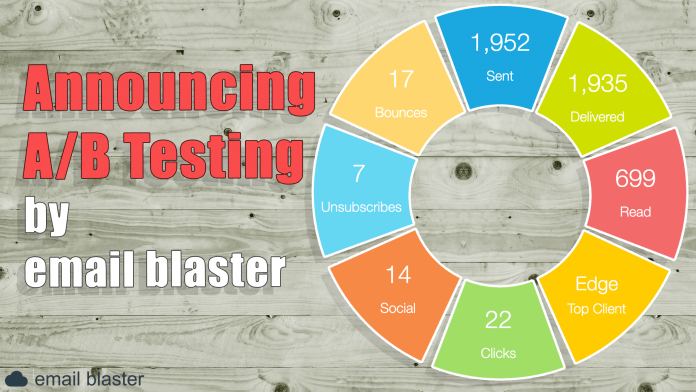What is A/B Testing?
A/B Testing (also known as split testing) is a method of comparing two or more versions of a marketing campaign to determine the top performer.
In most cases, we will vary one element so that we can accurately determine how this impacts the overall results of our digital marketing campaign. For example, if we are running an email marketing campaign, one of the most common elements to A/B test is the subject line of the email. Making a small adjustment to the subject line can often have a large impact on open rates. Certain subject lines (for example ones that contain a question) can often chime more with subscribers and prompt interest to open the email campaign and engage with it.
A/B testing effectively takes the guesswork out of a marketing campaign. By testing different variations of a marketing message, rather than relying on gut feel, we can apply a scientific experiment to determine what message or variation works best.
Why should you A/B test?
A/B testing removes the guesswork from your digital marketing campaigns. Often as marketers, we design what we believe to be the perfect digital marketing campaign. But that is a subjective area, what is the perfect email marketing campaign? By testing different variations of a campaign with an A/B testing app, we can clearly identify what works best, rather than relying on gut feel.
In a nutshell, A/B testing enables us to refine our marketing message by creating an understanding of what works and what does not with our marketing campaigns. One online publication sums it up quite well:
“If you’re not A/B testing your content, you’re leaving money on the table.”
How Does A/B testing work in the real world?
When we are A/B testing, we compare two (or more) variations of a marketing campaign against each other. For instance, if you are A/B testing the main tagline on your email campaign, you would create two exact copies to the same campaign with only the tagline changed.
After you have prepared your variations, you then send your email campaign to a random sample from your mailing list. The test will then tell you which version proved to be the most popular with your email subscribers, by comparing a specific metric such as clicks or conversion rates.
What Are The Best Elements To A/B test?
Some elements of your digital marketing campaign can impact conversion rates more than others. For example, if you are only changing one word in a long paragraph of text; this is unlikely to make much difference or provide any valuable feedback. To design your own successful A/B test, we would recommend experimenting with the following elements on an email marketing campaign:
-
Subject Header Line
This is one of the most common elements to A/B test. Experimenting with different email subject header lines can have a large impact on open rates. Using emojis inside the subject line can help you stand out in a crowded inbox. A/B testing this element will help you identify how much impact this really has on your opens.
-
Headlines and copy text
Experimenting with the actual design of your email campaign can also have a large impact on how long your subscribers are spending looking at your email. Sometimes just tweaking the call to action or headline at the top of your mailer can help grab attention and promote a better level of engagement.
-
Send from details
The send from details that you use on your email campaign often impact if your mailer will land inside your subscriber’s inbox or the junk folder. In addition to this, some email marketers find that sending from a real person i.e. Bob smith at Jo Bloggs Ltd often promotes more trust than sending from a generic department i.e. sales at Jo Bloggs Ltd. Experimenting with the send from settings can have a large impact on both open rates and inbox placement.
-
Send Time
Email marketing is an instant marketing medium. The message that you send arrives with your subscribers within a few moments of sending. Variations on your send time can often have drastic impacts on open rates. For example, if you are sending your email in the middle of the night, it is expected that open rates will be a lot lower compared to when your subscriber is sitting in front of their computer. With A/B testing you can experiment with sending on different days of the week, or different times of the day.
How To A/B Test in 2020?
A/B testing has been around for a few years, it is a tried and tested way of comparing two or more marketing campaigns to determine which one chimes best with your target audience.
A/B testing also is not very complicated or hard to set up. Start with a clear goal, what do you want to achieve and why? Is it better sales? More clicks on your email or just better open rates? After you have set a goal for your test, identify what exactly it is that you would like to test – perhaps two different subject lines or an email campaign?
The next task is to actually run your A/B test. If you are an email blaster user, we have just launched our brand new A/B testing app. Thankfully the app will do all the heavy lifting for you.
Inside your A/B testing app, it is simply a case of selecting what you would like to test i.e. two variations of email subject line. When you would like to test it (simply select a time and date to commence the test), and defining how the app should determine the winner, either by highest opens or highest amount of click-throughs.
How Long Should I Wait For My A/B Test Results?
After your A/B test has been dispatched it is important to allow time for your subscribers to interact with your marketing campaign and the analytics to be gathered. A subscriber may not open your email straight away, so it is critical to set a cooling-off period before you evaluate the results. By default, it is advised that you give a full 24 hours before evaluating the results of your A/B test. At a very minimum, you should allow 4 hours. If you are using the email blaster app, you can set the wait time as a customisable option when setting up your test.
How To Analyse A/B Test Results
With A/B testing software like Email Blaster A/B tester, data gets collected automatically. You can also view the progress of the test at any time from inside the app. After the test concludes, the app will automatically evaluate the winner (by either most clicks, or highest opens). A report will automatically get emailed to you, and the winning segment it auto dispatched to the remainder of your mailing list. So in a nutshell, most A/B testing app’s will do it all for you, it is just a case of setting up what you want to test and hitting ‘go’.
Conclusion
A/B testing has been around a long time. It is a tried and tested method to collect information about your design and copywriting choices and how they chime with your target market. Rather than relying on ‘gut feel’, A/B testing removes the guesswork, providing analytical data to guide you and your team on future design and marketing choices.
A/B testing is a powerful tool in the marketer’s arsenal. By using the new email blaster A/B tester, you can quickly and easily A/B test any element of your email marketing campaign.


